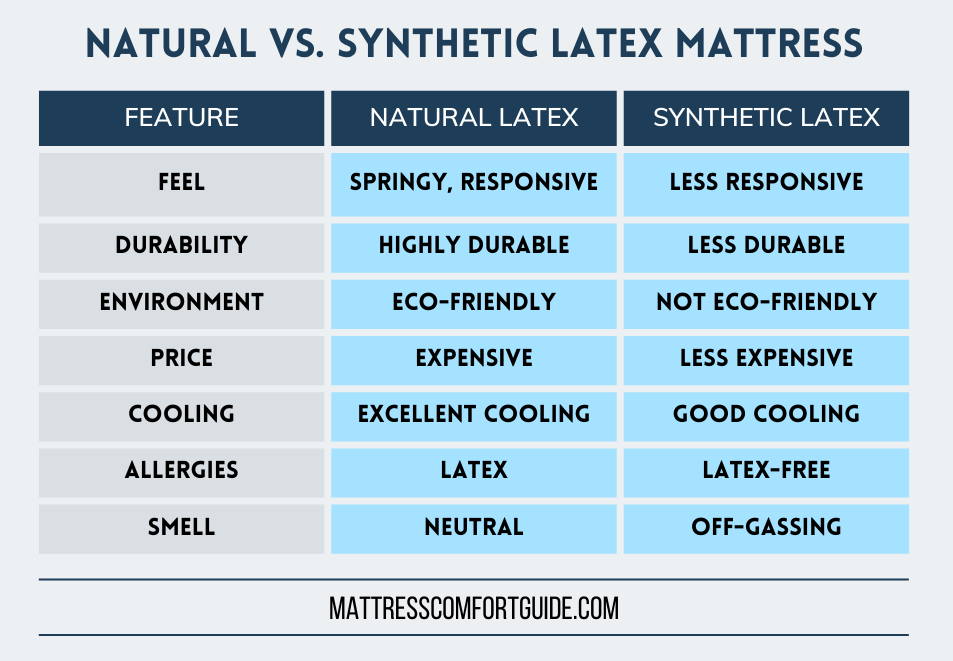
What’s the difference between Natural and Synthetic Latex Mattresses? Which is better? Natural latex mattresses are made using natural rubber sourced from the rubber tree. Synthetic mattresses are made using a mixture of petrochemicals to create a foam that mimics the properties of natural latex. The main differences between the two are the type of latex foam used, the feel, durability, and their environmental impact. See below for everything you need to know about Natural vs Synthetic Latex Mattress.

Jump Menu
• What Is a Natural Latex Mattress?
• What Is a Synthetic Latex Mattress?
• Key Differences: Natural vs. Synthetic
• Talalay vs. Dunlop
What Is a Natural Latex Mattress?
A natural latex mattress is made using latex foam derived from the sap of the rubber tree. They are called ‘natural’ because the latex comes from a natural, renewable, and sustainable source. These mattresses are a popular choice for individuals seeking comfort, support, and hypoallergenic qualities. They are also an eco-friendly option.

Natural latex mattresses are known for their durability and often last for 15-20 years or more. The latex foam conforms to your body’s contours, offers pressure relief, and helps maintain healthy spinal alignment. This makes them an excellent choice for people with back pain and those who want a responsive cushioning mattress.
RELATED
• How to Clean a Latex Mattress
• How Thick Should a Latex Mattress Be?
What Is a Synthetic Latex Mattress?
A synthetic latex mattress is primarily made using synthetic latex foam. This foam is constructed using man-made materials and chemicals. The latex is not sourced from the rubber tree. Instead, it is usually made using petrochemicals and an industrial manufacturing process.
Synthetic latex mattresses are designed to mimic the look and feel of natural latex mattresses. They are more affordable and appeal to people shopping on a budget. They are also a good choice for individuals with latex allergies because they lack the proteins found in natural latex that trigger the allergic reaction. However, they are not eco-friendly as they rely on petroleum-based materials in their production
The Key Differences: Natural Latex vs. Synthetic
Natural latex mattresses and synthetic latex mattresses have some key differences that can relate to their feel, durability, and environmental impact. Let’s take a closer look.

Type of Latex
The biggest difference between a natural and synthetic latex mattress is the type of latex foam used to make the mattress. A natural mattress uses real, natural latex sourced from the rubber tree. This latex rubber is then processed to create a foam that is used to create the mattress.
A synthetic latex mattress does not use natural latex. Instead, the latex foam is constructed by a chemical process. This involves mixing petrochemicals to create a foam that mimics the qualities of natural latex. It is not sourced from rubber trees and is a synthetic material.
• Winner: Natural Latex
Feel
Natural latex mattresses have a bouncy responsive feel. They are known for their excellent elasticity and support. They feel buoyant and change shape in response to pressure to contour the shape of your body.
Synthetic latex mattresses are designed to mimic the feel of natural latex mattresses. However, in general, they are not as responsive, buoyant, or supportive. They feel firmer and don’t offer the same pressure cradling and gentle body contouring properties.
• Winner: Natural Latex
Durability
Natural latex mattresses are more durable compared to synthetic. They are incredibly robust and have a life expectancy of 20-25 years. And, even longer if they are properly cared for. Synthetic latex is less durable. They begin to lose their shape and show signs of sagging more quickly. Natural latex is the best bet if you want a long-term investment in your sleeping comfort.
• Winner: Natural Latex
Environmental Impact
Natural latex is an eco-friendly choice. They are made using natural rubber from the rubber tree. This is a renewable, sustainable, and environmentally friendly material. Natural latex is biodegradable, synthetic latex foam is not. If you want to reduce your carbon footprint, choose natural latex.
• Winner: Natural Latex
Price
Price is a key difference when weighing up natural vs synthetic latex mattress. Natural latex mattresses are more expensive than synthetic equivalents. They are made from natural materials and have higher production costs. Synthetic latex is more affordable. If you are on a budget, a synthetic mattress may be more appealing.
• Winner: Synthetic Latex
Breathability
Breathability refers to a mattress’s ability to provide a cool sleeping surface by allowing warm air to escape the sleeping surface. This is an important feature for hot sleepers and people who live in warm climates. Natural latex is the clear winner in terms of breathability.

The open-cell matrix of natural latex provides excellent airflow. This draws warm air away from the mattress surface and replaces it with cooler air from beneath. Synthetic latex mattresses do not have an open-cell structure and don’t deliver the same level of cooling effect.
• Winner: Natural Latex
Allergies
Natural latex mattresses are hypoallergenic and resistant to dust mites and other allergens. However, they contain natural latex. And, some people are allergic to latex. Natural latex mattresses are not suitable for people who suffer from a latex allergy.
Synthetic latex mattresses are also considered hypoallergenic. However, they do not contain natural latex. And, this means they don’t contain the latex protein that triggers a latex allergy. This makes them suitable for anyone with a latex allergy.
• Winner: Synthetic Latex
Smell
Another key feature of natural vs synthetic latex mattress is smell. Natural latex mattresses have a mild to neutral scent. Some say the material smells similar to wood. Synthetic latex mattresses have a stronger smell. They tend to suffer from off-gassing. This occurs when volatile organic compounds escape the material and release an odor. Off-gassing produces a chemical smell but tends to fade with time.
• Winner: Natural Latex
What About Talalay vs. Dunlop?
There are two types of natural latex mattress on the market – Talalay and Dunlop. They are both made using natural latex rubber. However, the difference between the two comes down to how they are manufactured.

A Dunlop latex mattress is denser compared to Talalay. It has a firmer and more supportive feel. It is also heavier and more durable. This is due to its high-density foam formed during the manufacturing process. Talalay latex has a softer feel and delivers more gentle cushioning. They are made using lighter latex foam.
For more, check out our full guides below
• Talalay Latex Mattresses
• Dunlop Latex Mattresses
ABOUT THE AUTHOR
JOSH HARDY – Senior Editor
Josh is senior editor at Mattress Comfort Guide. He is an industry expert with over 30 years of experience in the bed and mattress industry. Josh is a native of Albuquerque and is a graduate of the University of New Mexico. He holds an M.S. in Project Management and a B.S. in Earth & Planetary Sciences.
He has worked in both the retail and manufacturing industries where he has held consultancy roles on mattress design and technologies. Josh has a particular interest in how different mattress types complement body size and sleeping position, and deliver optimal lumbar support. Josh is a keen sports fan and when he’s away from the office he likes to play basketball and catch the New Mexico Lobos games with his two sons at the Pit.